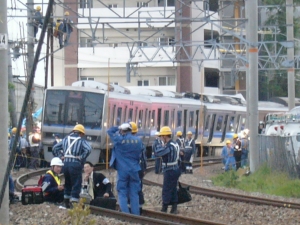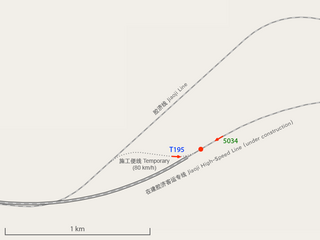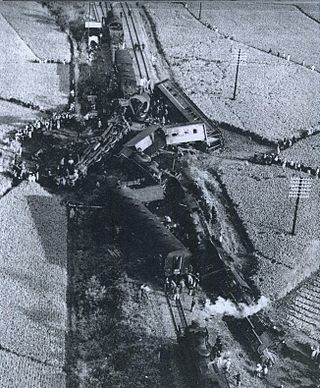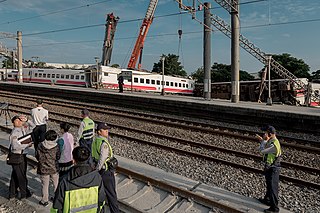
The Amagasaki derailment occurred in Amagasaki, Hyōgo Prefecture, Japan, on 25 April 2005 at 09:19 local time, just after the local rush hour. It occurred when a seven-car commuter train came off the tracks on West Japan Railway Company's Fukuchiyama Line in just before Amagasaki on its way for Dōshisha-mae via the JR Tōzai Line and the Gakkentoshi Line, and the front two cars rammed into an apartment building. The first car slid into the first-floor parking garage and as a result took days to remove, while the second slammed into the corner of the building, being crushed into an L-shape against it by the weight of the remaining cars. Of the roughly 700 passengers on board at the time of the crash, 106 passengers, in addition to the driver, were killed and 562 others injured. Most survivors and witnesses claimed that the train appeared to have been travelling too fast. The incident was Japan's most serious since the 1963 Tsurumi rail accident.
There have been a number of train accidents on the railway network of Victoria, Australia. Some of these are listed below.
The railways of New South Wales, Australia have had many incidents and accidents since their formation in 1831. There are close to 1000 names associated with rail-related deaths in NSW on the walls of the Australian Railway Monument in Werris Creek. Those killed were all employees of various NSW railways. The details below include deaths of employees and the general public.

The Zibo train collision was a major train collision that occurred on the morning of April 28, 2008, near the city of Zibo, in Shandong province, People's Republic of China. The collision occurred on the Jiaoji Railway, which links the important cities of Qingdao and Jinan in Shandong province. With a death toll of 72 people and 416 injuries, the collision was the deadliest rail accident in the People's Republic of China since a 1997 accident in Hunan.
Tze-Chiang, also Tzu-chiang or Ziqiang, is a type of limited express train service operated by Taiwan Railway (TR). Of the five service classes operated by TR, the Tze-Chiang service is the fastest. Ticketing is done on the basis of mileage.
This is a list of significant railway accidents in Queensland, Australia.

The Rokken train wreck occurred on October 15, 1956, when two passenger trains collided and derailed at Rokken Station on the Japan National Railways (JNR) Sangu Line in Matsusaka, Mie Prefecture. The accident led to improvements in the Japanese rail signaling system.

The Dien Sanh train crash occurred on 10 March 2015 when a passenger train struck a lorry obstructing the line on a level crossing near Dien Sanh station, Quảng Trị Province, Vietnam. One person was killed and four were seriously injured.

On 21 October 2018, a passenger train derailed in Yilan County, Taiwan, killing 18 people and injuring 187. At the time, it was Taiwan's deadliest rail accident since a collision near Miaoli in 1991 that killed 30 people.

On 2 April 2021, at 09:28 NST (01:28 UTC), a Taroko Express train operated by the Taiwan Railways Administration (TRA) derailed at the north entrance of Qingshui Tunnel in Heren Section, Xiulin Township, Hualien County, Taiwan, killing 49 people and injuring at least 200 others. At the time of the accident, the train was carrying 494 passengers. The eight-carriage train derailed after colliding with a construction truck that had fallen down a slope onto the tracks north of Hualien City; the train came to rest in the tunnel, with severe damage and many casualties. The train incident was primarily due to human factors and was preventable, as an investigation from The New York Times, revealed that it was "systemic failures at a government agency" including "a culture of complacency and weak oversight", that had made the disaster possible.









